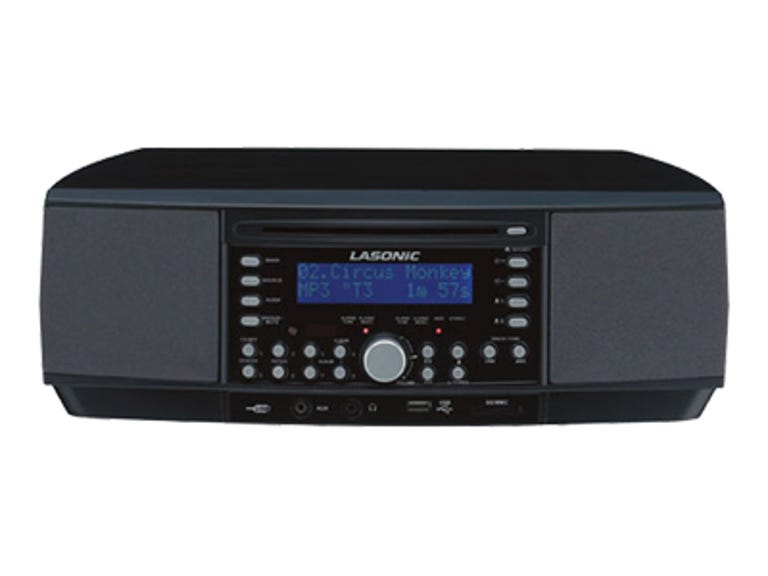 Why You Can Trust CNET
Why You Can Trust CNET Lasonic MSU-2020 review: Lasonic MSU-2020
Lasonic MSU-2020
Once a niche market dominated by Bose, the tabletop radio scene is now a bona fide cottage industry. In addition to models from Cambridge Soundworks, Tivoli Audio, and Boston Acoustics, Polk Audio's I-Sonic has even added HD Radio, XM support, and DVD playback features heretofore unseen in the category. Just as you're ready to upgrade your aging Sony Dream Machine clock radio, however, the exorbitant price tags on these devices hit you in the face: $350, $500, even $600. But don't blow that PlayStation 3 fund just yet: for less than $200, you can pick up the Lasonic MSU-2020. Unlike any of the pricey competitors mentioned above, the MSU-2020 offers front-panel USB and SD/MMC card slots for easy MP3 playback. Or, that was the plan, anyway.
The Good
The Bad
The Bottom Line
From a distance, the MSU-2020 might be confused with any of those other tabletop radios. It has the same general size (5.25 inches high by 15 inches wide by 10 inches deep) and is available in black or white. The 12-pound weight gives the Lasonic a heft that makes it at least feel like it's not supercheap. The front panel is dotted with 23 small buttons and a centered jog dial. Suffice it to say, that's far too many buttons, and the fact that they're spaced evenly and are all the same size and shape makes for a very nonintuitive navigation experience. The dial pulls double duty as a volume knob and a do-it-all adjustment switch once you hit the Jog button to toggle among its various functions (bass and treble adjustment, clock settings, and so forth). The blue LCD panel is light sensitive, so it's bright in bright rooms and more muted in the dark. The included remote also includes 24 buttons, but they're arrayed in a somewhat more logical and usable manner.
From a features standpoint, the Lasonic is better than average. It has the standard tabletop radio basics: AM/FM tuner, slot-loading CD player (it plays standard audio CDs as well as home-burned MP3 CD-Rs and CD-RWs), and "his and her" dual alarms (wake to any music source, or an alarm tone). But flip down the narrow door on the front panel, and you get two other options: a USB port and an SD/MMC flash media card slot. You're supposed to be able to use either one to read MP3s from mass storage-compliant USB music players and flash drives (on the USB port) or MP3-laden flash media cards (SD or MMC). The flash media slot worked well enough--usually--but none of the USB music players or flash drives we tried worked. (A Lasonic representative claimed that the company was "aware that the USB slot is a bit picky," and went on to suggest that we make sure we were using capacities below 2GB--which we were.) We also noted that songs played from the flash media card were often punctuated by a random pop when skipping back or forth from one track to the next.
In addition to the radio, CD, and flash media sources, the MSU-2020 offers two 1/8-inch minijack auxiliary inputs--one on the back panel and one on the front. That means it'll double as a set of speakers for your iPod or for anything else you'd opt to attach. There's also a line-out port, a headphone jack, and ports for the included AM and FM antennas. (The internal FM antenna wasn't particularly adept at pulling in stations, so you'll probably want to use the external one.) Wish the MSU-2020 had a built-in iPod dock? Upgrade to the $300 MSU-2030i, and your dreams will come true (except for the built-in iPod dock, they're essentially identical).
The MSU-2020's LCD offers a quite legible two-line display with 16 characters per line, and you can set the text to scroll or remain static. In addition to providing useful control feedback when setting various configurations, the display delivers ID3 info from MP3s, CD Text on compatible audio CDs, and RDS (Radio Data Service) text on many radio stations. You can save a total of 30 radio presets--20 FM plus 10 AM. When the unit is off, the display reverts to a clock, which you can choose to display in the 12- or 24-hour format. The Lasonic also includes a sleep timer and a snooze function in conjunction with its dual-alarm function. But for snooze especially, the tiny front-panel buttons are a real detriment--pity the groggy office drone who tries to remember which of the 23 miniscule keys is the correct one to depress at 6:30 in the morning. On the bright side, snooze time is adjustable from 5 to 22 minutes.
We weren't prepared to be blown away by the sound of the Lasonic MSU-2020--and we weren't--but it was certainly as good as if not better than many of the $100 to $300 iPod speaker systems we've heard this year. The default sound is somewhat narrow and thin, but toggling from Stereo to Wide and adjusting the treble and bass helped enormously. The 2020 could go nice and loud without distorting, and bass was decent enough (once we cranked it up). In other words, if you're stepping up from a clock radio or a bargain boombox, you may very well be pleasantly surprised, but don't expect the Lasonic to go toe to toe with a similar unit from Cambridge, Bose, or Boston Acoustics.
We'd like to see Lasonic fix the USB functionality, deliver a more intuitively designed set of front-panel controls, and price this type of unit closer to $150. In the meantime, given that one of its distinguishing features--the USB input--didn't work for us, it's hard to recommend the MSU-2020. As an alternative, for instance, we'd probably opt for something like the Philips MCD702--not a tabletop radio per se, but an attractive bedroom minisystem that offers DVD playback and is available for less than $200.


